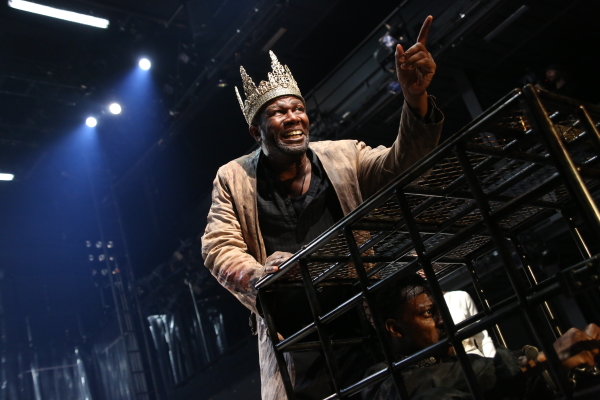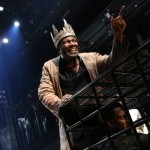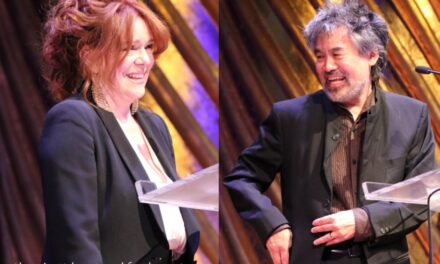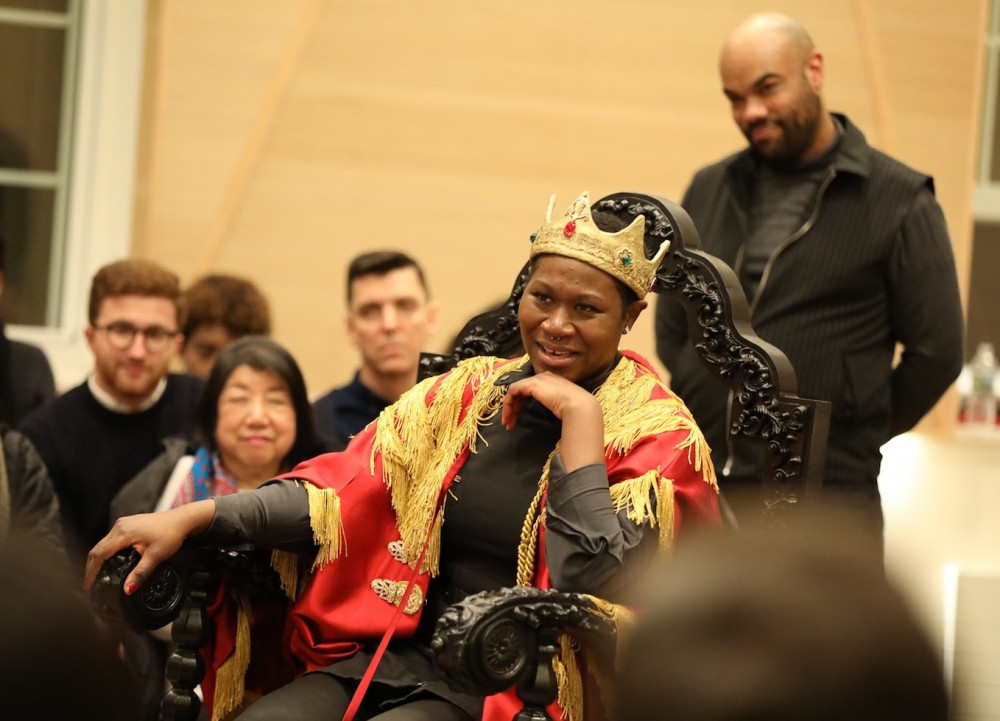Theater Review by JK Clarke
It would seem that almost nothing has changed since the era of the events taking place in Christopher Marlowe’s sixteenth century bloodbath, Tamburlaine Parts I & II (now playing through December 21 at Theatre for a New Audience’s Polonsky Shakespeare Center in Brooklyn). The core subject matter—the wholesale slaughter of thousands of innocents at the behest of power-hungry fanatics—could be lifted from today’s newscasts with nary a change of geography or motive. But despite there being very little comfort in sitting through a play first produced in 1587 (and set centuries before) and realizing that fact, that’s exactly what makes Tamburlaine such an important play to produce. Its last major production on a New York stage was in 1956, but it could not be any more relevant today.
Tamburlaine Parts I & II is the story of a bloodthirsty megalomaniac, Tamburlaine of Scythia (an ancient region of nomadic peoples that existed from around 11BC to 2AD, roughly encompassing what we know as Eastern Europe and stretching into parts of Asia and as far south as today’s Saudi Arabia) who endeavors to take over the world, one slaughter at a time. Much in the spirit of (the later but more familiar) Genghis Khan, the shepherd Tamburlaine, who will rise to be king of half the planet, seeks to invade, conquer, unite, repeat. But like all true narcissistic despots, he eventually fancies himself greater than the gods, and that may prove his undoing.
It is supposed that Marlowe was embracing the revolutionary idea that the will of man was, or could be, as great as God’s—a wholly blasphemous and dangerous notion in the sixteenth century. However, the text seems to the modern reader merely a drawn out display of excessive violence, punctuated by scene after scene of brutal Tamburlaine invading a country and murdering both the king and the vast majority of his citizens. These gory moments, coupled with the three-and-a-half hour run time (including a half hour intermission during which the crew cleans war detritus from the stage), should make for a difficult evening to sit through. But that’s far from the case in this terrific production.
What director (and, importantly, script editor) Michael Boyd (along with the help of an absolutely riveting cast) has done is made the mundane magnificent. Unlike Shakespeare, one doesn’t necessarily see a Marlowe play for the beauty of its language (although, to be fair there are rich, eloquent speeches here and there). Rather, Marlowe (whose career preceded Shakespeare’s by a decade or two) was known for his incendiary and daring viewpoints (he is said to have been both atheist and gay, either of which were grounds for execution during his lifetime) and groundbreaking style (e.g. introduction of blank verse) which heavily influenced and led to Shakespeare becoming Shakespeare. But what Boyd has done is to make that sociological daring come alive on stage. This production features such a new approach to stage war that gasps of amazement could be heard from the audience each time a character was killed in a symbolic and somehow elegant manner: in one example (it would be something of a spoiler to describe them all, for they make the play what it is), blood drips from the ceiling on to the head of an emperor who crumples to the ground. And aided by the incredibly versatile and vast Polonsky Shakespeare Center; Tom Piper’s intense and beautiful costumes and set; Arthur Solari’s haunting and dynamic live percussion soundtrack; and Sam Pinkleton’s choreography, it’s the staging that pulls us in and transfixes us. This is a horrifying war that’s impossible to look away from.
None of the brilliant staging would work without an exemplary cast (though the entire production feels like one large organism, not individual parts). While most actors play several different speaking roles (some as many as five) they are able to differentiate them so effectively that despite the confusing context of the play we are not confused by the multiple roles. But it’s the masterful John Douglas Thompson who takes the production by the yoke and drives it. He perfectly captures Tamburlaine’s passion, drive, ruthlessness and charisma. He’s not afraid to proclaim, in almost wooing fashion to his captive princess/bride-to-be Zenocrate (elegant and enigmatic Merritt Janson), that he “means to be a terror to the world.” Talk about hubris!
Other standout performances include Keith Randolph Smith’s hulking, twig-chewing, Tamburlaine henchman, Techelles; Ian Saint Germain as young Callapine, the orphaned and captive son of a murdered king; Chukwudi Iwuji as various soon to be conquered kings; most especially, Paul Lazar first as King of Persia, then Soldan of Egypt and Almeda the Jailor. Even a play like this can’t be all death and destruction, and providing enormous counterbalancing comic relief from the outset, Lazar—whom you might recognize as the nerdy moth specialist at the Smithsonian in The Silence of the Lambs—hilariously plays, in each role, a loopy, good-natured idiot, equal parts Emperor Claudius and Inspector Clouseau.
While it may be a long route to deliver a relatively simple message (that mankind is woefully repeating the history it has not learned from), it is no matter: this is an epic. A transformative, transcendent display of the destructive path of a brutal warrior. We feel, at the end, like we’ve slogged through the desert with Peter O’Toole in Lawrence of Arabia, but for some reason we can’t imagine not having done it and so much so the wiser.
Tamburlaine Parts I & II. At Theatre for a New Audience’s Polonsky Shakespeare Center (262 Ashland Place, between Lafayette Ave and Fulton Street, Brooklyn). www.tfana.org
Photo: Gerry Goodstein























